Antenna Installation Tips - For information on where to place your antenna, mounting, wiring, professional installation, and grounding use this information for your guidance.
How to Install an Outdoor TV Antenna in 7 Steps - Steps of installation of an Outdoor TV antennas :
1. Prepare and check your instrument and materials
2. Choose the side of a house where it is better to install
3. Install an antenna, connect it to a set-top-box
4. Check the signal and adjust the antenna
5. If the signal is bad, change the orientation or the place of the antenna
6. If the signal is good, you have finished.
7. Watch your TV
What You Need
Installation is very simple process, you don't need to have many instruments with you
 |
| Pliers |
Pliers
You need the pliers to screw nuts, bend a metal wire and cut cables and tiers.
Plastic tiers
You need them to fix cables and rods. It is a good idea to have tiers of different colors and length.
A metal wire
You need it to fix cables and rods in places where you can’t use tiers.
An electrical tape
You need it to isolate connectors of antenna.
An antenna
Use only antennas recommended by specialists.
RG6 cable with connectors 10-20 meters long is usually enough for one installation.
Use thick rods or metal rods/pole 1.5-2m for a balcony and a roof installation (don’t use thin rod!)
If you need long pole rods, you may ask the client to prepare them for you.
Don’t use antennas like this is your location far away from TV Tower Station
These two antennas are good only if you are very close to a transmitter tower (no more than 1 km) and conditions are good.
These two antennas are good only if you are very close to a transmitter tower (no more than 1 km) and conditions are good.
This is an antenna for cars. You can’t receive good TV signal with this antenna unless there is a special transmitter in your city
This antenna is for vertical polarized signals. You can’t receive a good signal with an antenna like this.
Don't use antennas like tihis, This antenna can cost much money. This antenna will not work for a long time. This antenna is not good because birds can make nests inside it.
Recommended Antennas
I tested many types of antennas and found that these designs showed the best results. You can try different antennas yourself and find the best for you!
Big Antenna
This antenna is big. Use big antennas only if the distance to the transmitter is big (more than 20km).
This antenna will work badly if the distance to the transmitter is small.
Small and medium antennas
The first antennas are medium. You can use these antennas if the distance to the transmitter is medium (5-20km)
Don’t use these antennas without a booster if the distance to the transmitter is very long.
The second antennas can work badly if the distance to the transmitter is less than 5km
This antenna is small. Use a small antenna if the distance to the transmitter is less than 3-5km
Example Phillips Outdoor TV Antenna Installation
Safety Instructions
This part is from Phillips user manual for Safety during Outdoor Antenna Installation, annd can be applied in the same way for other outdoor antenna installation.
Antenna grounding and safety warning
1. Outdoor antennas and lead-in conductors from antenna to a building, should not cross over open conductors of electric light or power circuits. They should be kept away from all circuits to avoid the possibility of accidental contact.
2. Each conductor of a lead-in from an outdoor antenna should be connected with an antenna discharge unit. Antenna discharge units (or Lightning Arrester) should be located outside the building or inside the building between the point of entrance of the lead-in and the TV, and as near as practical to the entrance of the conductors to the building.
Important Safety Notes
If you do not feel comfortable or competent to install this antenna we recommend that you seek the assistance of a qualified professional antenna installer.
Read the instructions for this device thoroughly before attempting installation.
The installation or dismantling of any antenna near power lines is dangerous.
Each year hundreds of people are killed or injured while attempting to install or service antennas. For your safety and proper antenna installation, read and follow all safety precautions.
Choose an installation site for safety as well as perfomance.
All electric power lines, cable lines and telephone lines look alike. To be safe, assume ANY overhead line can kill you. Do not place an antenna where it could potentially fall on to, or blow into a power line. If in doubt call your electric provider. Let them review your site.
Outdoor antennas should be grounded with an approved lighting arresting device. Local codes may apply. Use 8 AWG or larger ground wire.
Height or other restrictions on antennas may apply to your installation depending on your proximity to an airport, or local ordinances.
Take the time to plan your installation procedure. Do all assembly work on the antenna on the ground. Raise the completed antenna after assembly.
Do NOT work on a wet, snowy or windy day or if a thun- derstorm is approaching. Do NOT use a metal ladder.
If the antenna assembly starts to fall, get away from it and let it fall. Remember that the antenna mast and cable are all excellent conductors of electrical current.
Do NOT install the antenna by yourself. Be sure that there are two other people available for help.
If any part of the antenna should come in contact with a power line . . .
DON'T TOUCH IT OR TRY TO REMOVE IT YOURSELF. Call your local power company immediately. They will remove it.
Should an electrical accident occur . . . DON'T TOUCH THE PERSON IN CONTACT WITH THE POWER LINE, or you too can become electrocuted. Instead, use a DRY board, stick, or rope to push or pull the victim away from the power lines and antenna. Once clear, check the victim. If he has stopped breathing, immediately administer cardiopul - monary resuscitation (CPR) and stay with him. Have some - one else call for medical help.
Install wire antennas high enough that they will not be "walked into" by people.
Do not install antema wire (s) over or under utility lines.
An antenna is like an eye. A signal is like light. A TV tower is like a lamp. But this light is invisible for human eyes. Any antenna must see a signal. If an antenna sees no signal, a set-top-box or a TV-set can’t work.
Direct signal
A TV signal can be DIRECT or REFLECTED. A TV signal is DIRECT when an antenna sees a TV tower and there are no big buildings between the antenna and the TV tower.
This antenna sees a DIRECT signal
Reflected signal
A TV signal can be reflected from walls, building and trees like light is reflected by a mirror. This signal is called a REFLECTED signal. Not every building, wall or tree can give a good reflected signal.
This antenna sees a REFLECTED signal from the wall
How to point an antenna
An antenna is like an eye. This eye needs to see light. You need to point an antenna to a TV tower or to a reflected signal.
An antenna has the front end and the rear end. The front end MUST be pointed to a TV tower or to a reflected signal. In this case the antenna will see signal like an eye sees light.
This is the front end of the antenna. You point it to a TV tower or to a reflected signal.
This is the rear end of the antenna. You use it to mount an antenna on a thick bamboo rod, a metal pole etc.
Don’t make your STB blind!
Getting more signal is not always good. If an antenna is big and a TV tower is close, a STB can’t work properly because it gets blind. It gets blind like a human eye gets blind from strong light. If the signal is strong, use medium or small antennas.
What is the best place for an antenna? (Part 1)
The best place on a house for an antenna:
1. Place an antenna as high as possible. Install an antenna on a roof with a thick bamboo pole if possible.
2. Place an antenna on the side from which you can see a TV tower.
3. Place an antenna on the side from which you probably have a REFLECTED signal.
Not always you can easily understand which side is the best. Sometimes you have to try several different places to get a good signal!
Not always you can easily understand which side is the best. Sometimes you have to try several different places to get a good signal!
What is the best place for an antenna? (Part 2)
At first you need to choose the right side of a building, where to place an antenna. The best side is the side in the direction of a TV tower. You can place an antenna on the best side and point the antenna to a TV tower.
If the client lives not in the best side of a house, you can place an antenna on any side and point the antenna to the nearest tall building, wall, tree or tower. The nearest tall building, wall, tree or tower can give a REFLECTED signal.
Where does a reflected signal come from?
A row of buildings in a street. Try to point an antenna to front of the buildings.
A big building (like the Vattanac building). A big building gives a good reflected signal. Try to point an antenna to high buildings
A big wall or a roof. Try to point an antenna to big walls or to a roof of houses near the antenna.
A big tree. A big tree gives not a good reflected signal, but you can try.
Example of how to point an antenna to a TV tower
This antenna is pointed in the best possible way – directly to the TV tower.
The TV tower is in this direction, but you can’t see it.
If you can’t see the TV tower, but you know where it is – point an antenna in that direction first.
It is very important to find the direction of a TV tower. Use your knowledge of the land to find the direction of a TV tower! You can use Google Map or Open Street Map.
Example of how to point an antenna to the nearest tall building
This antenna is pointed to the nearest tall building. This building can give a REFLECTED signal.
This method is not 100% good. If you don’t have a good signal, try other possibilities.
Example of how to point an antenna to the skycrapper
If you live near a skycrapper building, try to point an antenna to the skyscraper. The skyscraper is tall and can give a REFLECTED signal.
Example of how to point an antenna to the nearest house
Reference : TV antenna installation guidelines or how to become a good signal hunter - Alexander Serov










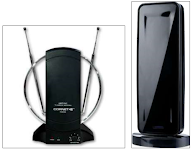


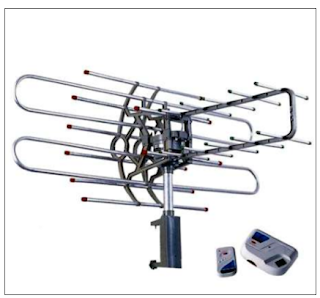










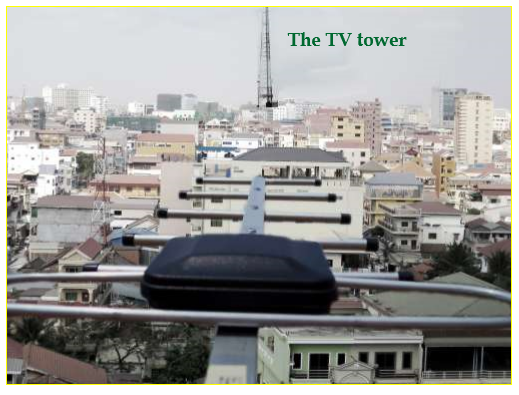
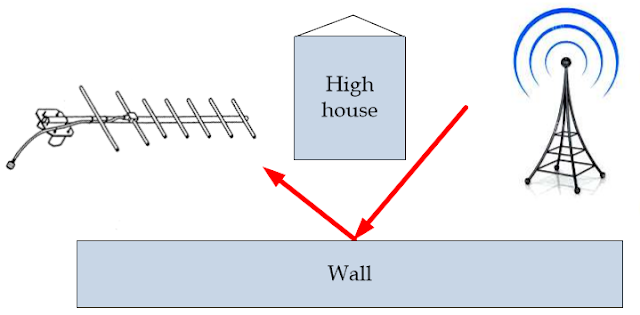

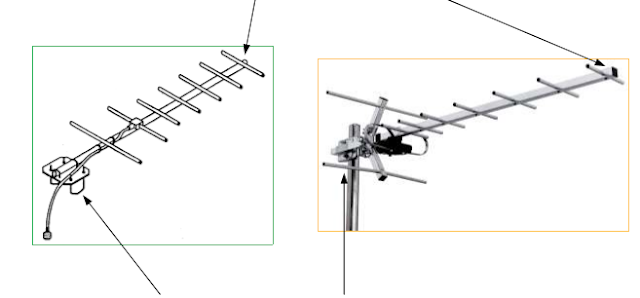













No comments:
Post a Comment